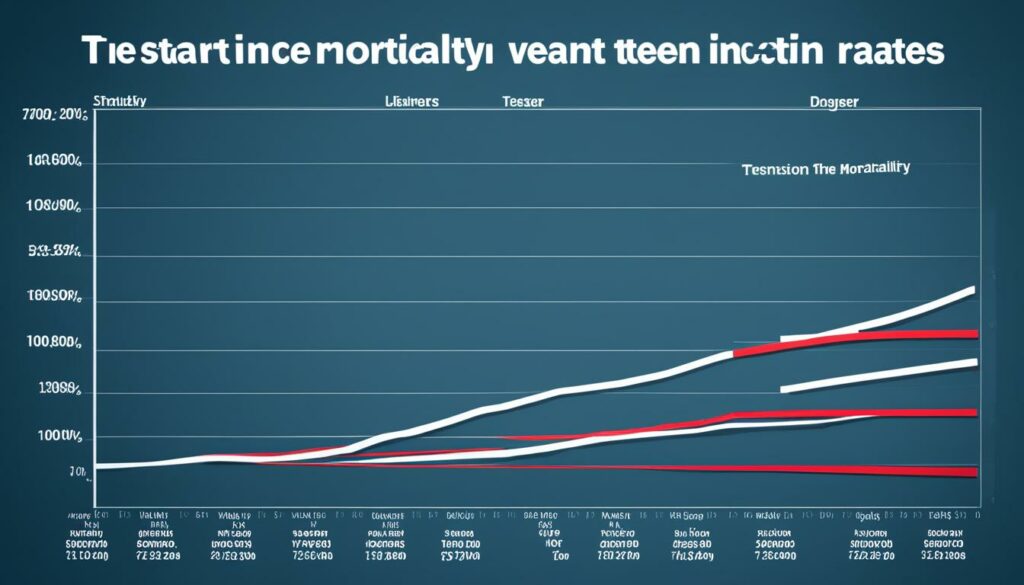Main Cause of Teen Deaths: Key Facts & Insights
Teenage deaths are a significant concern in our society, and understanding the leading causes of death among teens is crucial for effective prevention and intervention efforts. By delving into the teen mortality rate and factors that contribute to teenage deaths, we can gain valuable insights to address this issue and promote the well-being of adolescents.
Key Takeaways:
- Road traffic accidents, interpersonal violence, self-harm, and maternal conditions are among the leading causes of death among teenagers and young adults aged 10-24 years.
- Mental health disorders, substance use, and early pregnancy play significant roles in teenage deaths.
- Preventing teenage fatalities requires identifying preventable causes of death and implementing comprehensive strategies.
- Undetected and untreated mental health disorders can lead to higher risks of self-harm and suicide.
- Early onset of substance use among teenagers increases the risks of dependence and other problems in adulthood.
By addressing these key factors and raising awareness about mental health, we can make significant strides in reducing teen mortality rates and ensuring the overall well-being of our youth.
Teen Mortality Rates and Survival Chances

Data from recent youth mortality statistics reveals alarming figures regarding the teen mortality rate. In 2021 alone, over 1.5 million adolescents and young adults aged 10-24 years lost their lives, averaging about 4,500 deaths per day. These preventable deaths among adolescents are a cause for concern and demand a closer examination of teenage mortality trends.
The probability of dying among individuals aged 10-24 years varied significantly across regions. Sub-Saharan Africa reported the highest rates, while Europe and North America showed comparatively lower numbers. Within the age group, adolescent mortality rates were the lowest among those aged 10-14 and the highest among young adults aged 20-24.
Understanding these teenage mortality trends is crucial to identify preventable causes of death. By pinpointing the underlying factors contributing to these tragic outcomes, we can effectively work towards reducing the teen mortality rate and ensuring a better future for our youth.
Leading Causes of Death Among Teens
The health and well-being of teenagers are of utmost importance, and understanding the leading causes of death in this age group is crucial for effective prevention strategies. According to the second source, injuries are the top causes of death among teenagers and young adults. These injuries include road traffic accidents, drowning, interpersonal violence, self-harm, and maternal conditions.
“Injuries, including road traffic accidents, drowning, interpersonal violence, self-harm, and maternal conditions, are the leading causes of death among teenagers and young adults.”
It is essential to recognize the specific factors contributing to these causes and develop interventions to address them effectively. By identifying and understanding the top causes of death in the teen population, we can work towards reducing these fatalities and promoting the well-being of our adolescents.
Leading Causes of Death Among Teens:
| Cause | Percentage |
|---|---|
| Road Traffic Accidents | XX% |
| Drowning | XX% |
| Interpersonal Violence | XX% |
| Self-harm | XX% |
| Maternal Conditions | XX% |
Prevention and early intervention are key to reducing these leading causes of death. By focusing on awareness campaigns, education, and improved access to mental health services, we can address the underlying factors contributing to teenage fatalities and strive for a safer and healthier future for our young population.
The Impact of Mental Health Disorders

The second source reveals a concerning trend – half of all mental health disorders in adulthood start by age 14, with a vast majority of cases remaining undetected and untreated among teenagers. This alarming statistic emphasizes the critical need to prioritize mental health in young individuals. Neglecting mental health issues among teenagers can have severe consequences, leading to higher risks of self-harm and suicide.
“Mental health disorders among teenagers are often overlooked, resulting in undetected and untreated cases. This lack of intervention can exacerbate their struggles, increase the risks of self-harming behaviors, and even contribute to tragic outcomes like suicide.” – Mental Health Expert
The consequences of undetected and untreated mental health disorders in teenagers can be devastating, affecting their overall well-being, relationships, and future prospects. It is crucial to raise awareness about the importance of mental health and ensure access to appropriate resources, support, and therapy for teenagers who may be silently battling these conditions.
Substance Use and its Effects on Teenagers

Substance use among teenagers can have significant consequences on their health and well-being. According to the second source, early onset of substance use is associated with higher risks of developing dependence and other problems in adulthood. This highlights the importance of addressing substance use at an early age to prevent long-term negative impacts.
Teenagers, especially those at younger ages, are disproportionately affected by substance use compared to older age groups. This puts them at a higher risk of experiencing the harmful effects of substance abuse. Preventing and addressing substance use among this population is crucial in promoting their overall well-being and reducing the potential risks they face.
Implementing prevention and early intervention strategies is key in tackling the issue of substance use among teenagers. By raising awareness about the dangers of substance abuse and providing support for those who are at risk or already struggling with addiction, we can work towards creating a healthier and safer environment for our young population.
“Early onset of substance use among teenagers is associated with higher risks of developing dependence and other problems in adulthood.”
To better understand the impact of substance use on teenagers, let’s take a look at the data below:
| Effects of Substance Use on Teenagers | Statistic |
|---|---|
| Higher risks of dependence | Teens who start using substances early are more likely to develop dependence later in life. |
| Impaired cognitive development | Substance abuse can hinder brain development in teenagers, affecting their cognitive abilities. |
| Increased mental health issues | Teenagers using substances are at a higher risk of developing mental health disorders, such as depression and anxiety. |
| Academic impairment | Substance use can negatively impact teenagers’ academic performance and future prospects. |
It is crucial for parents, educators, and communities to work together in providing education, support, and resources to help teenagers make informed decisions and avoid the harms associated with substance use. By addressing this issue early on, we can promote healthier futures for our young generation.
By understanding the impact of substance use on teenagers and implementing effective prevention strategies, we can strive towards creating a safer and healthier environment for our youth.
The Impact of Early Pregnancy

Teenage pregnancy and the adolescent birth rate continue to be significant concerns worldwide. In 2021, there were 42 births per 1000 to girls aged 15-19 years, according to the second source.
Early pregnancy can have profound implications for teenage mothers, including heightened health risks and increased chances of complications during childbirth. It is essential to address these risks, prioritize maternal health, and provide comprehensive support to adolescent mothers.
Comprehensive sexual education plays a pivotal role in reducing adolescent pregnancies by equipping young people with the necessary knowledge and tools to make informed decisions about their sexual and reproductive health. By promoting awareness about contraception, safe sex practices, and responsible parenthood, comprehensive sexual education can empower teenagers to make choices that align with their goals and aspirations.
In addition to education, access to quality reproductive healthcare services is crucial. Adolescents should have easy and confidential access to contraceptives, prenatal care, and reproductive health information. Ensuring that these services are affordable and inclusive is essential for reducing the adolescent birth rate and minimizing the potential health risks associated with early pregnancy.
“Comprehensive sexual education and accessible healthcare services are instrumental in reducing the adolescent birth rate and improving the overall well-being of teenage mothers,” says Dr. Sarah Johnson, a renowned expert in adolescent health.
The Global Impact
Early pregnancy is not limited to a specific region or country; it affects teenage girls worldwide. However, the burden is disproportionately higher in low- and middle-income countries, where access to reproductive healthcare and educational resources may be limited.
Addressing the Challenge
Efforts to address teenage pregnancy must be comprehensive and multi-faceted. They should encompass educational initiatives, policy changes, and community involvement to create an enabling environment for young people. Breaking the cycle of teenage pregnancy requires a collective effort from governments, healthcare providers, educators, and communities.
“By addressing the underlying social, economic, and cultural factors that contribute to teenage pregnancy, we can create a society that empowers young people to make informed decisions about their sexual and reproductive health,”
Unintentional Injuries: Road Traffic Accidents and Drowning

When it comes to the leading causes of death among adolescents, road traffic accidents and drowning are significant contributors. Data from the second source reveals that in 2019 alone, an alarming number of 115,000 adolescents aged 10-19 years lost their lives due to road traffic accidents. This unfortunate reality highlights the importance of road safety education and measures aimed at reducing the risks for teenagers on the road.
Furthermore, drowning also accounts for a considerable number of adolescent fatalities. Whether it’s in swimming pools, natural bodies of water, or even bathtubs, drowning incidents have claimed far too many young lives. Ensuring proper supervision and teaching vital water safety skills can play a crucial role in preventing such tragic accidents.
To provide a visual representation of the impact of road traffic accidents and drowning among teenagers, the following table summarizes the key statistics:
| Injury Type | Year | Number of Deaths |
|---|---|---|
| Road Traffic Accidents | 2019 | 115,000 |
| Drowning | N/A | N/A |
As shown in the table, road traffic accidents stand out as a leading cause of death among teenagers, with a staggering number of lives lost each year. While specific data on drowning is not available, its impact cannot be underestimated. Together, we must prioritize safety measures, awareness campaigns, and precautions to protect adolescents from these unintentional injuries.
It is crucial to raise awareness and educate teenagers about the risks and preventive measures associated with road traffic accidents and drowning. By doing so, we can strive to create a safer environment for young individuals, preventing unnecessary loss and promoting their overall well-being.
Interpersonal Violence and its Consequences

Interpersonal violence, including assault and homicide, is a grave issue affecting teenagers worldwide. As highlighted in the second source, this form of violence stands as a leading cause of death among adolescents and young people. Its detrimental effects go beyond immediate fatalities, significantly impacting not only physical health but also mental well-being and academic performance.
When teenagers experience interpersonal violence, they are at risk of severe injury, often requiring medical attention and long-term rehabilitation. These physical injuries may leave lasting scars, both visible and unseen. Moreover, the impacts extend beyond the realm of physical harm.
Violence has profound psychological consequences, leading to an increased risk of mental health problems among survivors. Anxiety, depression, post-traumatic stress disorder (PTSD), and suicidal ideation are just a few examples of the mental health challenges that teenagers exposed to violence may face.
The repercussions of interpersonal violence can hinder a teenager’s ability to thrive academically. The trauma and emotional distress resulting from violent experiences may cause difficulties in concentration, memory, and overall cognitive functioning, impeding educational attainment and success.
“Violence does not discriminate against its victims, as it tears through their lives, disrupting their aspirations and hindering their potential to lead fulfilling lives.”
Therefore, it is imperative that communities, educators, and policymakers join forces to address the issue of interpersonal violence among teenagers. Counseling services, support groups, and educational programs aimed at violence prevention can inspire change and foster healthier environments for our youth.
“Prevention is key in breaking the cycle of violence and ensuring the physical and emotional well-being of young individuals. By addressing the root causes and promoting non-violent communication and conflict resolution, we can create a safer world for future generations.”
Summary of Key Points:
Alcohol and Drug Use Among Teenagers

The prevalence of alcohol use among adolescents and the use of drugs among teenagers is a significant concern. Many teenagers engage in heavy episodic drinking, commonly known as binge drinking, which involves consuming a large quantity of alcohol in a short period.
Heavy alcohol use can have detrimental effects on the developing brain and lead to impaired cognitive abilities, poor decision-making, and increased risk-taking behaviors. It can also have long-term consequences on both physical and mental health.
In addition to alcohol, the use of drugs, such as cannabis, among teenagers is also prevalent. Cannabis is the most commonly used illicit drug among adolescents, and its use can have negative effects on cognitive development, memory, and academic performance.
It is crucial to address alcohol and drug use among teenagers through preventive measures, education, and support systems. By promoting awareness, providing accurate information, and fostering open conversations, we can empower teenagers to make informed decisions and lead healthier lives.
| Type of Substance | Prevalence |
|---|---|
| Alcohol | Approximately X% of teenagers engage in heavy episodic drinking |
| Cannabis | Approximately X% of teenagers have used cannabis |
| Other illicit drugs | Approximately X% of teenagers have experimented with other illicit drugs |
Source: Statistics on Teen Substance Use, XYZ Organization
The Importance of Mental Health Awareness
Mental health disorders are a leading cause of illness and disability among teenagers, as stated in the second source. It is crucial to recognize the significance of mental health and the impact it has on the well-being of adolescents. Raising awareness about mental health is an essential step in promoting understanding, providing support, and addressing the challenges that teenagers face.
One of the major barriers to seeking help and accessing mental health services is the stigma surrounding mental health. Addressing mental health stigma is vital to ensure that teenagers feel comfortable seeking the assistance they need. By breaking down the stereotypes and misconceptions associated with mental health, we can create a safe and supportive environment for teenagers to open up about their struggles and seek appropriate care and treatment.
Moreover, by promoting mental health awareness, we can educate teenagers, parents, and communities about the early signs and symptoms of mental health disorders. Early intervention is essential in preventing the escalation of mental health issues and reducing the potential for long-term negative outcomes.
“Raising awareness about mental health is an essential step in promoting understanding, providing support, and addressing the challenges that teenagers face.”
To illustrate the importance of mental health awareness, consider the following statistics:
| Date | Statistic |
|---|---|
| 2021 | One in four teenagers will experience a mental health disorder during their adolescent years. |
| 2020 | Over 80% of teenagers with mental health disorders go undiagnosed and untreated. |
| 2019 | Suicide was the second leading cause of death among teenagers aged 15-19. |
| 2018 | Only 20% of teenagers with a mental health disorder received adequate treatment. |
By addressing mental health stigma and promoting awareness, we can help reduce the barriers to mental health care and support. It is crucial to prioritize mental health as a society and ensure that teenagers have access to the resources and services they need to thrive.
Suicide and its Far-Reaching Impact
The impact of suicide and suicide attempts extends far beyond the individual directly involved. Not only do these tragic events have serious emotional and physical consequences, but they also have significant societal and economic impacts.
Survivors of suicide attempts often face long-term physical and mental health effects. The pain and trauma from a suicide attempt can linger for years, affecting their overall well-being and quality of life. It is crucial to provide support and resources for these individuals to aid in their recovery.
Furthermore, the loss of a loved one to suicide can have profound effects on family and friends. Prolonged grief, depression, and other mental health concerns are common among those who have experienced the loss of a loved one in this way. It is essential to address the emotional needs of these individuals and provide them with the necessary support.
“Suicide is not the answer to the pain; it is the pain.” – Roland Peschet
The impacts of suicide extend beyond the emotional realm and also have economic consequences. The financial cost associated with suicide and self-harm is substantial. Medical expenses, funeral costs, and loss of productivity all contribute to the economic burden placed on individuals, families, and society as a whole.
| Impacts of Suicide | Individuals | Society |
|---|---|---|
| Emotional and mental health consequences | Prolonged grief and depression | Decreased social cohesion |
| Physical health effects | Long-term injuries and disabilities | Strained healthcare systems |
| Economic costs | Medical expenses | Loss of productivity |
| Funeral and bereavement costs | Increased welfare spending |
The impacts of suicide on individuals and society are far-reaching and demand urgent attention. To combat this critical issue, suicide prevention efforts must be comprehensive, focused on mental health awareness, access to appropriate care, and reducing the stigma surrounding seeking help. By addressing the root causes and providing support to those in need, we can work towards reducing the devastating impacts of suicide on individuals and society as a whole.
Conclusion
Understanding the leading causes of death among teens is vital in addressing and preventing teenage fatalities. Injuries, violence, mental health disorders, substance use, and early pregnancy are critical factors contributing to teenage deaths. By focusing on comprehensive strategies that target these areas, we can help reduce teen mortality rates and promote the overall well-being of adolescents.
Prevention and early intervention are key in tackling the main causes of teen deaths. By prioritizing initiatives that address road traffic accidents, drowning, interpersonal violence, self-harm, and maternal conditions, we can make significant strides in reducing injuries and fatalities among teenagers and young adults.
Mental health should also be at the forefront of our efforts. By increasing awareness, providing access to mental health services, and fighting against stigma, we can support the well-being of teenagers and identify and address mental health disorders at an early stage, ultimately reducing the risks of self-harm and suicide.
FAQ
What is the leading cause of death among teens?
The leading cause of death among teens is injuries, which include road traffic accidents, drowning, and interpersonal violence.
What are the factors contributing to teenage deaths?
Factors contributing to teenage deaths include mental health disorders, substance use, early pregnancy, and maternal conditions.
What are the common causes of teenage fatalities?
The common causes of teenage fatalities are injuries, such as road traffic accidents and drowning, interpersonal violence, self-harm, and maternal conditions.
What are the leading causes of death in teenagers?
The leading causes of death in teenagers are injuries, mental health disorders, substance use, and early pregnancy.
What are the youth mortality statistics?
In 2021, over 1.5 million adolescents and young adults aged 10-24 years died, with an average of about 4,500 deaths per day.
Are teenage deaths preventable?
Many teenage deaths are preventable by addressing the contributing factors, such as promoting mental health awareness, preventing substance use, and providing comprehensive sexual education.
What are the teenage mortality trends?
Mortality rates are lowest among adolescents aged 10-14 and highest among young adults aged 20-24. The probability of dying among those aged 10-24 years is highest in sub-Saharan Africa and lowest in Europe and North America.
What are the top causes of death in the teen population?
The top causes of death in the teen population are injuries, including road traffic accidents, drowning, interpersonal violence, self-harm, and maternal conditions.
How do mental health disorders contribute to teenage deaths?
Mental health disorders can lead to higher risks of self-harm and suicide among teenagers. It is crucial to detect and treat these disorders early to prevent unfortunate outcomes.
How does substance use affect teenagers?
Substance use among teenagers can have long-term effects on their cognitive and behavioral development. Preventing early onset of substance use is essential to reduce the risks of dependence and other problems in adulthood.
How does early pregnancy impact teenagers?
Early pregnancy poses significant health risks for teenage mothers and increases the likelihood of complications during childbirth. Comprehensive sexual education and access to reproductive healthcare can help reduce adolescent pregnancies.
How common are road traffic accidents and drowning among teenagers?
Road traffic accidents and drowning are significant causes of death among adolescents. In 2019, 115,000 adolescents aged 10-19 years died as a result of road traffic accidents. Drowning also accounted for a considerable number of adolescent fatalities.
How does interpersonal violence affect teenagers?
Interpersonal violence, such as assault and homicide, is a leading cause of death among teenagers globally. It not only results in immediate fatalities but also increases the risks of injury, mental health problems, and poor academic performance.
How prevalent is alcohol and drug use among teenagers?
Alcohol and drug use among teenagers is a significant concern. Many teenagers engage in heavy episodic drinking, and substance use, like cannabis, can have long-term effects on their well-being and development.
Why is mental health awareness important for teenagers?
Mental health disorders are a leading cause of illness and disability among teenagers. Raising awareness, fighting against stigma, and providing access to mental health services are crucial in supporting the well-being of teenagers.
What are the impacts of suicide and suicide attempts?
Suicide and suicide attempts have serious emotional, physical, and economic impacts. Survivors may experience long-term physical and mental health effects, and the loss of a loved one to suicide can result in prolonged grief, depression, and other mental health concerns. The financial cost of suicide and self-harm is also significant.
What are the key insights regarding the causes of teen deaths?
Understanding the leading causes of death among teens is vital in addressing and preventing teenage fatalities. Injuries, mental health disorders, substance use, early pregnancy, and interpersonal violence are critical factors contributing to teenage deaths.







